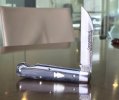From the Guardians Thread by
 cudgee
cudgee
9 October 2021 page 2632. The pictures have been deleted. Maybe
 cudgee
cudgee
could put them back in.
"
Recently i took on a project to try and improve a lambsfoot that i have, it was sort of successful but not what i wanted to achieve. But in the process my curiosity was aroused, i had done some research, but there was limited material out there. I wanted to know how much actual dye could be removed from the bone covers of a knife. After my experiment, i came to the conclusion that dark colours could not be removed completely, but you would have more success with lighter colours. My father had many sayings, one was, if you want to know how to do something, ask someone who does it for a living, and another was, don't be afraid to have a go at trying something new yourself, that way you will learn by YOUR mistakes. So i hunted around and found a woman online who's career is collecting bone and making trinkets and ornaments with it. She scrounges bone from dead animals in the bush, and buys bone from professional hunters. I emailed her with some questions, and she said my conclusion about dark dye being nearly impossible to remove compared to light dye was correct, but she also pointed out something that i would never had known, the longer a dye is in the bone no matter what colour it is becomes nearly impossible to remove. This got me thinking, so i have come up with an idea that we can all participate in and learn from. My thinking is, as i have attempted this already and with what i have already learnt, and with a what we are about to attempt, we can all learn something and members of the porch my find the conclusions helpful into the future if they are attempting to mod their own knife covers.
So this is the project, and i am making it like a class project like we use to have in school, so all comments, observations and input is welcome, this is not just my project it is for everyone here who is interested, so feel free to join in. I have a supposed knife nick opener, for that, it is not worth a cold pie, but i use it as an emergency screwdriver but mainly as a scraper to clean knife strops, for that it is brilliant, and as our little mate Rachel pointed out, great for opening pistachio nuts, and who doesn't love them

.
This is it as of now.
The first part of the experiment will be to soak it in 6% solution Hydrogen Peroxide, i will observe it and take notes and photos over however long it sits in the solution. We want to see how much dye can be removed over what period of time, normally i would say because it is a light colour we would be able to get it back to white bone, but as the woman pointed out, because we don't know how long the dye has been in the bone this may not be achievable. So it may sit in the solution from a few days to up to a month, i have no idea, but i will keep replacing the 6% solution if and when it becomes inactive. We also want to observe what happens to the metal, one of my concerns with my knife was damage to the liners and backspring and pins with long term submerging in the solution. They did tarnish badly, but that was removed easily and they polished up really well.
The second part, and we will discuss this later, will be trying a re-dye project, but we will see what happens with the dye removal first. So anyone who reads this and would like to ask any questions, or has any suggestions or other input please join in, as i stated this is for everyone to maybe learn something on a subject with not much information out there, or worst, some misinformation.




 ) Bone could get badly damaged or the results could be unsatisfactory and blotchy I'd fear.
) Bone could get badly damaged or the results could be unsatisfactory and blotchy I'd fear.


